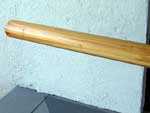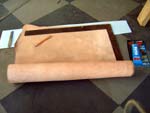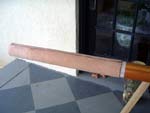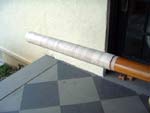Inspired by John Welsford's
recent
article,
I finally got around to leathering the lower part of my mast. After a
season of sailing Skat, the mast step and partner had worn parallel
rings around the mast (for building articles, look
here,
here,
and
here;
for sailing, look
here
and
here).
After shaving the mast down with a spokeshave and sanding smooth, I
refinished with multiple coats of Watco Teak Oil, a UV-resistant
linseed oil finish. If you look closely in the first picture, you can
see that the rings still show faintly, even after refinishing.

To prevent a repeat, I decided to cover the lower part of the mast in
leather for better abrasion resistance, much like leathering a pair of
oars. After seeing John's article, I considered leathering the partner
and step, but covering the outside of the mast seemed easier than
covering the inside of the partner and especially the inside of the
step inside the decked forward compartment.

I cut a piece of leather 24 incehes long and measured the diameter of
the mast at the base and 24 inches up. Though the mast has a bury of
only 21", I decided to go a little longer to cover all of the
refinished area. I used a builder's square to make sure that the edges
were straight and the corners were right angles.

I covered both the inside of the leather piece and the outside of the
lower 24 inches of the mast with Marine Goop, a type of contact cement.
(Curiously, the marine variety of Goop was significantly less expensive
than ordinary Goop at about $1 per ounce vs. nearly $5 per ounce; I
suppose we're far enough from the ocean that no one here knows that
adding "marine" to a label should increase rather than decrease the
price.) It took a good bit of glue to cover both the mast and leather.
I used up an entire 3 oz tube and would have liked a little more just
for good measure. As John recommends, use gloves to avoid getting glue
on the skin.

I let the cement dry for a few
minutes and then carefully rolled the
leather around the mast. My mast is laminated from 4 pieces of Douglas
fir, so there is a nice glue line running along the front and back of
the mast for alignment. John suggests putting the seam at the front
where the load will be least, though it seems to me that with the mast
driving the boat forward, the partner will be loaded at the front side
and the step at the aft side. Since I leathered the mast, I
suppose it won't make much difference, as partner and step will have
the seam at the same side--one will be optimal and one won't,
regardless of whether I went fore or aft.
After wrapping the leather, I put the mast down on the floor and rolled
it back and forth a couple of times to make sure that I had good
contact all the way around. I then wrapped the entire leathered area
with a spiral wrap of masking tape to maintain a bit of pressure while
the glue finished curing.

